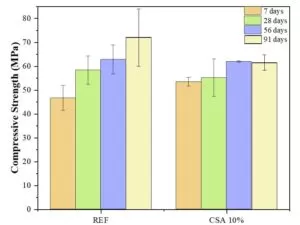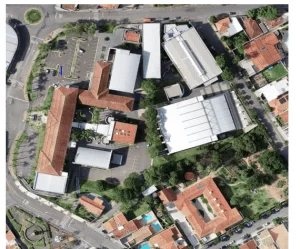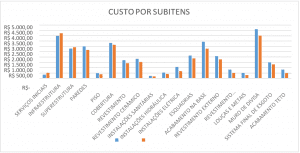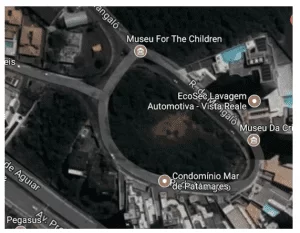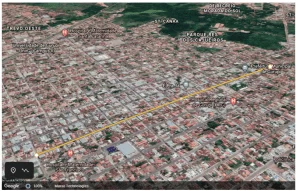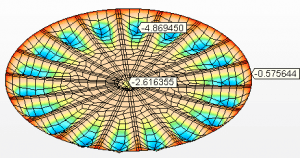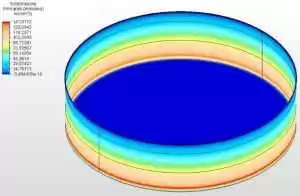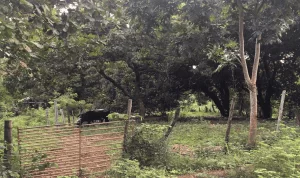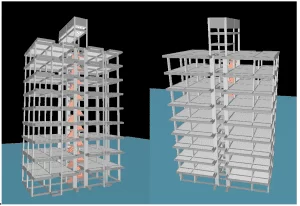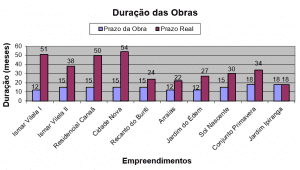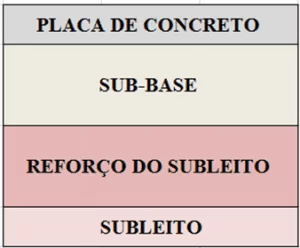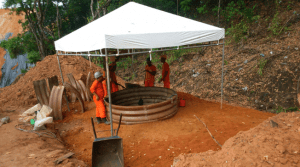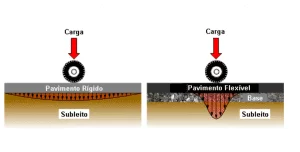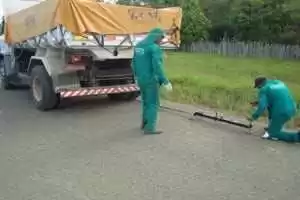ORIGINAL ARTICLE
NASCIMENTO, Jéssica Wanderley Souza do [1], SANTOS, Caíque Assunção dos [2], SAMPAIO, Allefy Teles [3], QUEIROZ, Filipi Magalhães de [4], BARRETO, Thiago de Albuquerque [5]
NASCIMENTO, Jéssica Wanderley Souza do. Et al. Functional evaluation of pathologies in flexible pavement. Revista Científica Multidisciplinar Núcleo do Conhecimento. Year 06, Ed. 06, Vol. 01, pp. 110-129. June 2021. ISSN:2448-0959, Access link in: https://www.nucleodoconhecimento.com.br/civil-engineering/flexible-pavement, DOI: 10.32749/nucleodoconhecimento.com.br/civil-engineering/flexible-pavement
ABSTRACT
Highways are of essential importance, since they are the main mode of transportation in the country, with a vast territorial extension of roads. However, many of these highways present some kind of alteration in their initial shape. The concept of paving, pathologies and their causes, as well as their recovery, are thus constituted. These problems were visually evaluated according to the Asphalt Pavement Restoration Manual of the DNIT (National Department of Transportation Infrastructure) in accordance with the TER 005/2003 and PRO 009/2003 standards, in a different area of the city of Manaus, namely the South Zone, consisting of the roads of the Industrial Complex, which allows the transportation of containerized cargo to the ports. The results, based on the visual surveys carried out and the current serviceability values, indicated roads with a concept between bad and regular.
Keywords: Pathologies, Floor, Highways.
1. INTRODUCTION
Today, the growth rate of the commercial vehicle fleet is increasing considerably, much more than was predicted when most of our highways were designed and built, and the effect of this is early deterioration of sidewalks with a wide variety of pathologies. This is the main reason that worries those responsible for the maintenance of these roads. Therefore, the knowledge of the pathological effects that these loads generate is crucial to take the right solutions, whether to correct functional or structural errors of the sidewalks, reducing time and costs. It is notorious that paved roads in poor condition negatively affect the economy, increasing fuel consumption, vehicle maintenance and pollution, all of which result in less competitive products on the market. The sidewalks in turn have an age of service, and the intense demands of traffic lead to pathological manifestations, both in highways and in urban roads. The main function of the sidewalk is to allow safe and satisfactory traffic throughout its life cycle (BRITO, 2007, p. 34).
The sidewalk management system is a process that covers all the activities involved with the purpose of providing and maintaining sidewalks at an adequate level of service. However, it involves from the initial obtaining of information for planning and budgeting to the periodic monitoring of the sidewalk in service, through the design and construction of the sidewalk and its maintenance and rehabilitation over time (CUNHA, 2004, p. 55).
Therefore, once the roads were chosen, with different traffic characteristics, a visual survey of the pathologies was carried out in order to assess the surface situation of these structures, aiming to understand the main causes of early deterioration of regional sidewalks, as well as the influence of irregularities on the comfort and safety of traffic users. Thus, the pathologies found in the evaluated section, taking into account that the sidewalk of the ZS section is the most requested and oldest. This last information could be verified in the surveys carried out in loco, where it was found in some segments of the sidewalk with higher demand, the presence of gravel from sandstone, sedimentary rock heavily exploited in Manaus in the 70s, but superficially scarce today.
2. FLEXIBLE FLOORING AND ITS PATHOLOGIES
According to DNIT (2005, p. 12), pathologies can be defined, according to the Aurélio dictionary, as the study of diseases in their broadest and most varied senses; as an abnormal state of known or unknown cause; as in the definition are the result of situations that range from the choice of material to the execution of preventive and corrective maintenance.
This type of sidewalk usually requires large thicknesses, due to the use of deformable materials and the application of high loads, or even because of the use of materials of dubious quality. Thus, such thicknesses ensure that the stress in the foundation soil is less than its resistance (PINTO, 2003, p. 67).
According to Balbo (2017, p. 87), flexible sidewalk is that which always includes a bituminous coating, whose materials used are asphalt that forms the overlay, a granular material that makes up the base, and another granular material or the soil itself that forms the sub-base. In relation to the rigid sidewalk, the flexible sidewalk presents a larger and more expressive elastic deformation, which in the road environment is called deflection. It is the sidewalk in which the absorption of stresses occurs between the layers in a divided manner, in which the vertical stresses are located in the layers below and concentrated near the load application. In flexible sidewalks, there is less cohesion between layers and they deform, forming a localized depression of considerable depth on the surface. The distribution of stresses in the soil of flexible sidewalk, in which there is a concentric zone with a small radius to the vertical of the load center in which the pressures are localized. That is why special care is needed at the sidewalk bed level.
When flexible sidewalk defects manifest themselves, they can be classified as surface defects, surface degradation or deformation. It is important to note that the terminology of the defects catalogued by the Brazilian standard DNIT 005 (2003, p. 3), and which are considered for calculating the sidewalk surface quality indicator (GGI – Global Severity Index) are: cracks (F); sinking (A); corrugation and transverse undulations (O); exudation (EX); wear or disintegration (D); pan or hole (P); and patching (R). These pathologies are associated with the sidewalk structure and surface, and will be discussed below, according to the terminologies and classifications found in the Brazilian standard as in other literature.
2.1 MAIN PATHOLOGIES
2.1.1 ASPHALT EXUDATION
Asphalt exudation occurs to the surface due to asphalt expansion in heat, which finds it difficult to occupy space due to the low volume of voids or excess binder, resulting in lower asphalt viscosity and consequent involvement of coarse aggregates and reduced macrotexture. Its shape is shiny and this is due to the excess of bituminous Binder (SILVA, 2008, p. 76).
2.1.2 WEAR AND TEAR
Wear and tear is associated with traffic and weathering. It is the result of poor bonding between the components of bituminous mixtures or their poor formulation, the use of unsuitable materials, and construction errors. When the stage of surface wear is advanced, there is the progressive pulling out of aggregates, which occurs as a result of the volatilization and oxidation of asphalt under the action of weathering and abrasive traffic, giving it a surface roughness (SILVA, 2008, p. 78).
An overheating of the asphalt or lack of binder may even occur if there is a progressive loss of aggregate soon after opening to traffic, resulting in a high macrotexture. The exposure of aggregates to many solicitations ends up evolving to the formation of pellets and nests. Another pathology that may be associated with the loss of aggregate is aggregate polishing, which, due to the deficient selection of aggregates, causes adhesion problems added to the potential of polishing the aggregates’ surfaces by the action of vehicle tires (BERNUCCI, 2006, p. 67).
2.1.3 RISE OF FINES
According to Pinto (2003, p. 38), the rise of fines occurs when the constituent materials of the layers move. It occurs when, in the presence of water from drainage and infiltration problems, they are expelled from the interior of the sidewalk through cracks. The expulsion of this water occurs by vehicles that exert compression when passing on the highway.
2.1.4 SLIPPING OF THE BITUMINOUS COATING
In slipping of the asphalt surfacing, crescent-shaped cracks are formed as a result of the displacement of the surfacing relative to the base. The low strength of the asphalt mix or the lack of adhesion between the overlay and the underlying layer are the reasons for the formation of crescent cracks. For Silva (2008, p. 61), vehicles are responsible for their formation when they cause slipping or deformation of the asphalt mix in the braking area.
2.1.5 CRACKS OR SPLITTING: FISSURE AND CRACK
The occurrence of cracks is one of the most frequent forms of degradation in flexible sidewalks. It is caused mainly by fatigue of the materials used in the bituminous layers due to repeated bending tensile stresses in these layers as a result of passing vehicle loads. This allowable number of load repetitions for the maximum tensile stress can be known when the effect of speed and viscoelastic material behavior is taken into account. Many studies on the fatigue of flexible sidewalks have even been performed using some software that, despite their limitations, allow to define several complex parameters, such as the viscoelastic properties of the asphalt and to define more precisely the detection and possible causes of cracks (BESKOU, 2016, p. 56).
According to Saboo (2016, p. 58), alligator hide type cracks are those characterized by a series of parallel longitudinal cracks. They represent the advanced stage of fatigue. Initially they present themselves in an isolated form. As they progress over time, they interlock and take on an alligator skin appearance. They tend to get worse with block detachment and nest formation.
According to Paulo Fernando Silva (2008, p. 90), automobiles do not cause structural problems, but rather the reduction of friction, which can cause accidents. The other factors for cracking are the granular layers not having support capacity, the surface layer having a high stiffness in relation to the other layers, or the materials used being of poor quality. When cracking occurs, reflection or crack propagation is said to occur. While reflection appears in new layers that were built on top of an already cracked layer, crack propagation starts inside the bituminous layer and propagates to the surface.
As for the degree of severity, cracks are classified as class 1 cracks (FC-1) up to class 3, and the higher the number, the more damaging the crack is to the sidewalk. For isolated cracks, the FC-1 classification is used, which are cracks with an opening larger than that of the cracks and smaller than 1 mm. FC-2 relates to cracks with an opening larger than 1 mm and without edge erosion. FC-3, on the other hand, is equivalent to cracks with an opening larger than 1 mm and with edge erosion. For interconnected cracks, the classification will always be FC-2 or FC-3 (ZBICIAKA, 2016, p. 54).
Block cracks, on the other hand, are formed due to shrinkage of the asphalt coating and daily temperature variations. Their formation is indicative that the asphalt has undergone strong hardening due to its oxidation or volatization of maltenes, making them less flexible. These cracks have a configuration close to that of a rectangle. Since they are not related to traffic, they appear anywhere, even in places with little traffic (SILVA, 2008, p. 95).
Longitudinal cracks occur in isolated forms and approximately parallel to the sidewalk axis. The most common types of cracks are alligator hide or crocodile skin cracks, isolated shrinkage cracks, block cracks, longitudinal cracks, transverse cracks, and edge cracks. Cracks that are formed due to fatigue may be isolated or interlocked. Those that are not caused by fatigue can be isolated or block (SABOO, 2016, p. 34).
According to Silva (2008, p. 78), they are caused among others due to poor execution of the construction joint, crack reflection, foundation settlement, shrinkage of the asphalt coating or early fatigue stage. They are called longitudinal, longitudinal when their length is greater than 1 meter, if it is less, they are called short longitudinal.
Transverse cracks are those that appear isolated and are perpendicular to the sidewalk’s axis. They are formed due to joint reflection or underlying cracks or shrinkage of the asphalt coating. It is called long transverse when its length is greater than 1 meter, otherwise the crack will be called short transverse. The disintegration of the edges initiates the evolution of the crack, followed by the penetration of water and weakening of the lower layers (SILVA, 2008, p. 65). Finally, edge cracking is that formed due to the unpaved shoulder, because there is excessive moisture in the layers or low thickness of the overlay and base layer. It is located at most 60 cm from the edge (ZBICIAKA, 2016, p. 72).
Potholes or pits appear due to a hole or cavity that forms in the coating, which can pass to the next layer, the base. It is a pathology that appears with the evolution of others, such as cracks – especially those of the crocodile skin type, sinking, wear, disintegration of the wear layer, and lack of adherence between the layers. Rainwater ends up being an aggravating factor, because its accumulation between surface cracks accelerates the degradation of the coating, which is known as stripping. The presence of water disintegrates the layers of sidewalk and, for this reason, it is common for rutting to occur. This pathology is part of the final stage of degradation and greatly affects vehicles. These speed up the process of rutting degradation (DNIT, 2005, p. 380).
2.1.6 WEAR LAYER
The pellets appear due to the reduced wear layer, a poor connection between this layer and the next bituminous layer and the lack of stability of the wear layer (PINTO, 2003, p. 96).
2.2 STRUCTURAL DEFECTS
Deformations usually arise as a result of the joint action of intense traffic and adverse weather conditions. They result from the deficiency of specific areas of the sidewalk, from localized contamination of granular layers or from the lack of bearing capacity of the foundation soil. If there is no intervention, the evolution of this pathology can lead to the formation of cracks and the rising of fines when the problem of poor drainage is present (DNIT, 2005, p. 381).
2.2.1 SINKING
Sinkholes are plastic or permanent deformations, which suffer longitudinal depression of the sidewalk surface. The deformations are caused by the action of tire loads that pass repeatedly (SILVA, 2008, p. 54).
According to Silva (2008, p. 67), it can be of the plastic subsidence or consolidation type. The former occurs because of plastic deformation of the sidewalk layers and also have elevations that go around the rutting. When they are up to 6 meters long, they are called local plastic, but if larger, they are called trail plastic. The consolidation type exists because differential consolidation occurs in layers of the sidewalk and/or subgrade. When they are up to 6 meters long, they are called local consolidation; when longer than 6 meters, they are called on-track consolidation.
2.2.2 CORRUGATIONS OR RIPPLES
Corrugations or ripples are also known as cow ribs. They are characterized by undulations transverse to the axis of the road, which occur in the wear layers consisting of surface coating. According to Silva (2008, p. 45), this is due to the unstable base resulting from poor execution and the low resistance of the asphalt mix, resulting in excess asphalt or fines. This pathology is associated with horizontal shear stresses that form in areas subjected to vehicle acceleration.
When present on the surface of the overlay, the undulations are called mass slippage and occur because of the asphalt mixture low stability as a result of traffic and weathering. For Pinto (2003, p. 86), these deformations result from poor distribution of the binder in bituminous concrete layers in which the mixture is dragged by excessive plastic deformation or resulting from foundation deformation.
2.2.3 RODEOS OR WHEEL TRACKS
Ruts or wheel tracks constitute longitudinal depressions and are the result of permanent deformations in any of the layers, caused by consolidation or lateral movement of the materials when subjected to the loads produced by traffic. Due to deficiencies in their formation or execution, high temperatures and because of the time of application of the loads, they end up not having an adequate load capacity. The layers and foundations, when they do not have sufficient bearing capacity, form large-radius encircles. The small radius ones are formed due to the low resistance to plastic deformation of bituminous mixtures (DNIT, 2005, p. 378).
According to Bernucci (2006, p. 76), for the functional evaluation of a sidewalk one must consider the appreciation of the sidewalk surface and how this state influences rolling comfort. One method is the serviceability of a given sidewalk section, which assigns values from 0 to 5 for the rolling comfort of a vehicle traveling on a given section at a given time in the sidewalk’s life. The limits of acceptability and trafeability are evaluated, and the parameter is the longitudinal irregularity, a measurement along an imaginary line parallel to the road’s axis.
Another evaluation is the objective one of the flexible sidewalk surface by determining the GGI in the survey of defects, in which spreadsheets are used to note the occurrences and calculate the absolute and relative frequencies of defects, material for the demarcation of piles and survey areas, and metallic lattice to determine the rutting in the wheel tracks of the areas analyzed according to the standards: DNIT 006/2003 – PRO (DNIT, 2003b) and DNIT 007/2003 – PRO (DNIT, 2003c).
2.3 DEGRADATION DUE TO VEHICLE OVERLOAD
The overload of vehicles causes accelerated degradation of the sidewalk that, the excess 1.0 ton in the weight of a triple tandem axle generates an increase of up to 80% of the Load Equivalence Factor (FEC) that is the factor responsible for the sidewalk design. The main defects caused by traffic overload are fatigue cracking and rutting in the wheel tracks (FONTENELLE, 2016, p. 32).
3. METHODOLOGY
An exploratory type research is proposed with its approach as the qualitative method that encompasses case studies both through bibliographical survey and interviews with people who have mastery of the studied subject, field research, and analysis of other examples that stimulate the understanding of the theme.
3.1 OBJECT OF THE CASE STUDY
The types of pathologies identified in this work were based on programs for evaluating the surface conditions of paved highways. The main defects found in flexible sidewalks are: cracks and fissures, patch deterioration, potholes and surface defects.
The work consists of the presentation of the work under study through observations and surveys carried out in the field. This observation of the pathologies caused in the pavement presented aims to point out the most frequent flaws and problems encountered.
Figure 1 – Location.

The procedure was done by walking along the stretch of road, where the pathologies were visualized according to those exemplified by the classification, and photographic and written records were made describing such pathology (Figure 1). They were also located by means of a mobile receiver device that uses the Global Positioning System (GPS), in order to be able to return, if necessary, for a later evaluation. When possible, measurements were taken of some pathologies, such as the length of cracks, for example. It should be noted, however, that measuring the defects on that road was difficult, due to the heavy traffic of vehicles, buses, light, medium and heavy trucks, from empty or loaded containers. The assessors mainly considered pans, protrusions, transverse and longitudinal surface irregularities. Large depressions resulting from embankment settlement were to be ignored according to the DNIT specification.
Among the functionalities of the coating are waterproofing and providing the final finish, improving comfort and skid resistance. This makes it possible to establish technically adequate solutions, indicating the best alternatives for the maintenance or restoration of the structure. Regarding the pathologies found on the stretches under study, there are, among other causes for the deterioration of the sidewalk: a) traffic action on the ZS SECTION (axle load), considering that Avenida General Rodrigo Otávio receives vehicles with heavy loads from the industries of the Industrial Pole of Manaus, the genesis of pathologies on the sidewalk is linked, in general, to poor project execution, construction problems, failure in material selection, use of materials with low resistance for the construction of the layers, and inadequate conservation and maintenance alternatives. These factors cause the structural failure of the coating and the sub-layers, causing problems in the rolling, comfort and safety of the road.
3.1.1 CRACKS AND FISSURES
In the sections under study, cracks were observed: a) longitudinal; b) transverse; c) block cracking, according to Figure 2; and d) “leather-of-jacaré” (Figure 3). Applying this situation, the main reasons for the defects are: a) inadequate bonding between sidewalk layers; b) and c) shrinkage due to the region’s high temperature; d) in addition to asphalt layer contraction due to high temperature, repeated deformations caused by heavy traffic and insufficient sidewalk thickness should be considered. All the cracks mentioned above were detected along the evaluated sections, varying only in severity.
Figure 2 – Block crack – Rodrigo Otávio Avenue (ZS).
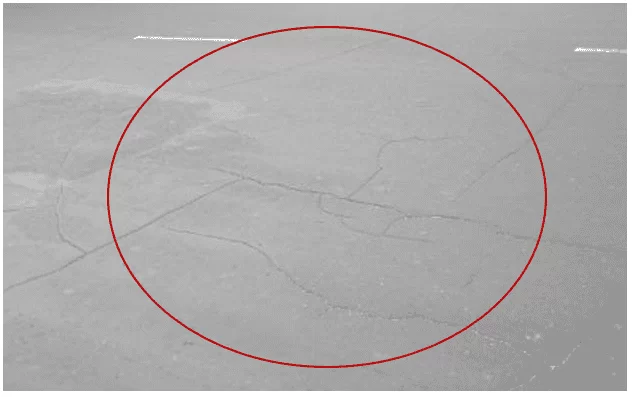
Figure 3 – Trincas couro-de-jacaré – Praia do Futuro Street (ZS).
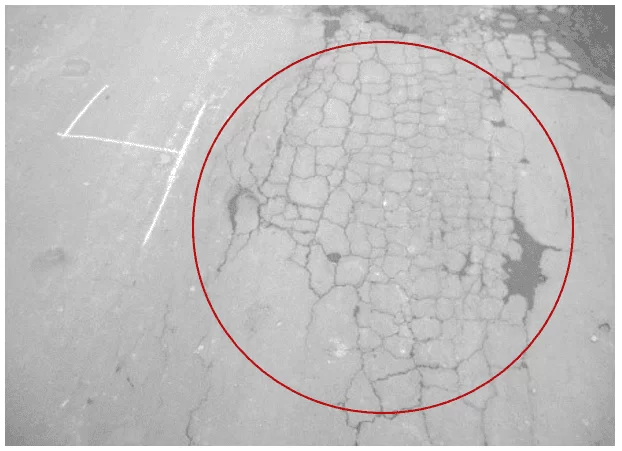
3.1.2 PATCH DETERIORATION
Patches represent the portion of the sidewalk surface larger than 0.1m² removed and replaced after initial construction. As with the evaluation of the severity level, the way to execute this pathology also depends on the type of defect presented, as described in the reference. This pathology was observed in several stretches of Avenida General Rodrigo Otávio, in both directions of traffic, as well as in the evaluated streets in the Tarumã neighborhood. The possible cause of this deterioration, incident in the stretches under study, is the slipping of the asphalt mixture after poor patching and errors in the dosage of the asphalt mixture, aggravated by increased temperature and excessive load, as shown in Figure 4.
Figure 4 – Patch with asphalt mix slip, with pan (ZS).
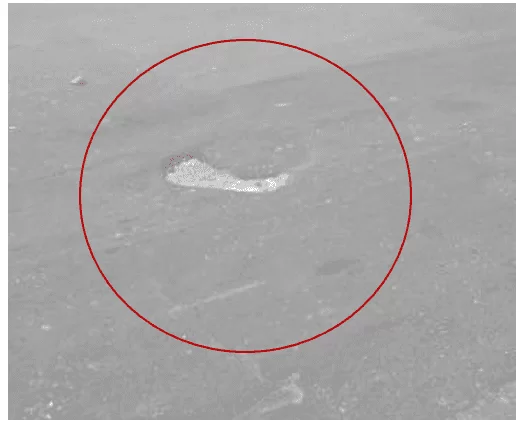
3.1.3 POTS
Figure 5 – Pans in cracks of the “alligator leather” type (ZS).
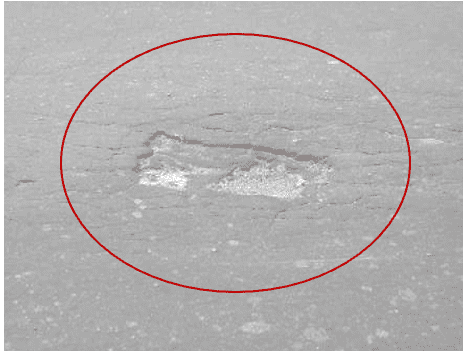
Several pans of varying magnitudes were found along the ZS stretch. At Av. Rodrigo Otávio, it became difficult to perform measurements of the dimensions due to the large flow of vehicles. According to the Manual of Evaluation, Maintenance and Restoration of Pavements of Urban Roads Rodrigues et al, there are several causes of these pathologies, among the significant number of this defect found on the aforementioned avenue of Manauense, the potholes with higher severity levels are shown in Figure 5.
In Figure 6, it can be seen that the genesis of this problem is possibly the fatigue of the coating, while Figure 7, shows a structural defect in the underlying layer, since this pathology was deep and could easily be seen in the base of the sidewalk.
Figure 7 – Deep pan (ZS).
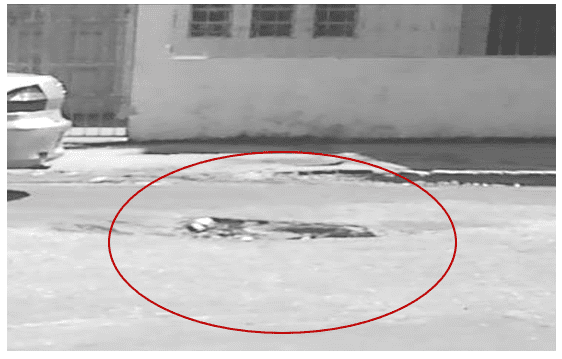
3.1.4 SURFACE DEFECTS
Figure 8 – Loosening of aggregate (ZS).
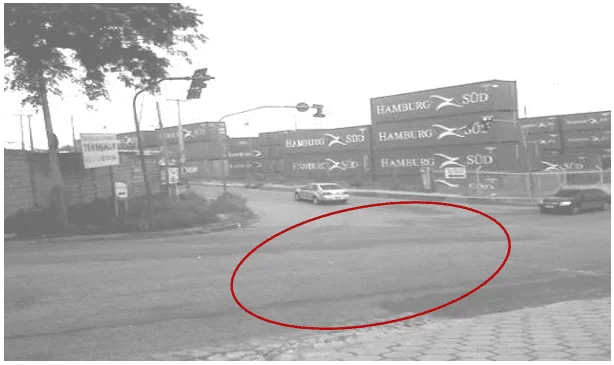
As for the pathologies related to surface defects, based on the references, rutting of wheel tracks, aging of asphalt mixtures, loosening of aggregate from the mixture, slipping of the coating, failures in the entrance and exit areas of the projects, and lack of adherence between the asphalt and the cobblestone surface were found. It was found that the pathologies such as loosening of the aggregate from the mixture, as shown in Figure 8, wheel tracks and slipping of the coating (Figure 9), are concentrated in certain stretches, while the aging of the mixture is found along the entire stretch where the potholing operation was not performed.
Figure 9 – Slippage (ZS).
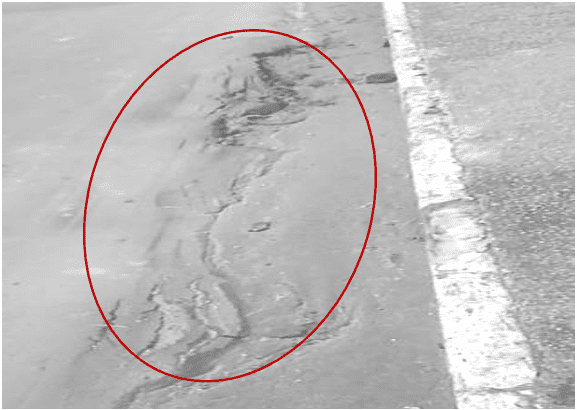
4. RESULTS AND DISCUSSION
4.1 INCIDENCES OF THE MAIN PATHOLOGIES SERVICE VALUE
To make a more direct comparison, the pathologies were grouped, resulting in four main groups: (a) Surface and Drainage Defects (Lift, Wheel Track, Rubbery, Rising, Sinking, Waviness, Wear, Drainage Box Unevenness, Gutter and Curb Failure, Lack of Surface Drainage, among others); b) Potholes; c) Patch Deterioration; and d) Cracks (Fissures, Longitudinal Cracks, Transversal Cracks, Block Cracks, “Leather-of-Jacaré” Cracks), according to Table 1.
Table 1 – Comparison between incidences of the main pathologies in the study stretches.
| Pathologies | Quantity |
| ZS | |
| Surface and Drainage Defects | 187
42 51 55 |
| Pots
Patch Deterioration |
|
| Cracks and Fissures |
Source: Data produced by the authors, 2020
By analyzing Table 1, it is immediate to observe the predominance of pathologies framed as Surface and Drainage Defects, among which, for the ZS section, the Wear from the lack of adhesion between the binder and the aggregate stands out. Exactly where this defect was observed, the coarse aggregate was pebble, which has a smooth surface, making adhesion with the binder difficult, resulting in the loss of the asphalt film that surrounds the aggregate with increasing traffic intensity. When analyzing the ZS section, it was found that most of the sidewalk defects are related to failures on the road shoulder, including the transition from the gutter to the roadway. The corrugations appear in an intermediate scenario as to incidence, but they connote deformations transverse to the axis of the road, arising from problems with the subgrade. The other pathologies in this group had a small sample, when compared to the above-mentioned, although they also have their degree of criticality, when analyzing the effect of aging, temperature variation, execution, water action, among other factors that affect the good behavior of the sidewalk throughout its service life.
The high incidence of patches and cracks in the two stretches under study can be observed. The recurrent patches observed can be elucidated when one understands that the genesis of the deterioration is the premature fatigue of the coating, caused by the lack of support of the lower layers (base and/or sub-base), which characterizes as a consequence of sidewalks in Manaus that usually have only two layers: the subgrade and the coating. Such defects were found with exhaustion.
The high number of inventoried cracks is explained by the grouping of all types (longitudinal, transverse, block and “leather-of-jacaré”) in a larger group. Even so, the wide occurrence of this defect is due to the fact that climate alternation occurs in Manaus, without regularity, causing small temperature variations, but capable of damaging a poorly executed coating, over a poorly resistant subgrade, leaving the structure vulnerable to the erosive action of water. In addition to the characteristics of the PAC used in asphalt mixtures in the Municipality of Manaus, such as Penetration (indicating insufficient viscosity for the regional characteristics) and Softening Point, whose surface temperature indicated is below the actual situation of regional sidewalks. In recent studies carried out in Manaus, the reflectivity (or absorption) of solar radiation actually influences the temperature rise in the coatings present. It was observed that the highest peak surface temperature (59.7°C) occurs on the sidewalk with the lowest albedo, in this case the Sand-Asphalt sidewalk and the lowest peak surface temperature (51.4°C) occurs on the sidewalk with the highest albedo/reflectivity, this being the rigid sidewalk.
On the other hand, the sidewalk’s Current Service Value was determined to decrease over time, mainly as a result of two factors: traffic and weathering. The weather contributes to the acceleration of sidewalk deterioration, since rainwater can cause a drop in bearing capacity. As a result, when the structure is subjected to traffic it will suffer greater displacement, causing structural and surface damage. The sidewalk already cracked on the surface facilitates the entry of water and, consequently, increases sidewalk damage. When this damage reaches low serviceability values, corrective maintenance must be carried out. As a result, the serviceability value rises again, and may reach values equal to or greater than the serviceability initially determined for this sidewalk. Based on the evaluation proposed by DNIT’s specification, according to Figure 10, for the traffic direction Bola da Suframa – Ports (ZS-1) and Bola da Suframa – Ports (ZS-2), the results CSV=2.9 and VSA=2.1 were obtained, respectively. Both characterized the road serviceability as regular. In the case of the streets evaluated in the Tarumã neighborhood, already in the ZO TRACK, VSA was classified as very poor, since CSV=1.0. This result can be explained by the fact that the sidewalk of the streets in this section has an expressive number of cracks and large pans, to the point of preventing the passage of a larger vehicle, patches and undulations that compromise comfort, besides the absence of surface drainage.
Figure 10 – Current serviceability values.
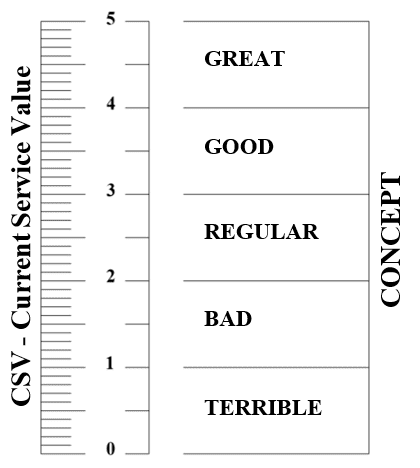
5. CONCLUSION
The main pathological agents that cause the defects in the sidewalks are basically the action of traffic on a paving structure that does not have the capacity to support the underlying layers of base and sub-base, which is characteristic of the region to be structured only in coating and subgrade, and the intercalation of climatic periods between very dry and heavy rainfall, coupled with high temperatures. It is noteworthy that Manaus has an AAUQ coating laid on a clay subsoil. These factors added to the poor execution of sidewalks and the erosive action of water trigger a series of defects visibly found in the city’s urban roads (e.g. in the study).
In particular, the most common defects in the stretches of the South Zone are surface and drainage failures, due to lack of preventive maintenance, correct execution and use of appropriate material. The application of pebble as coarse aggregate in the mixtures for the surfacing is associated with the appearance of defects, leading to wear due to the poor adhesion between the binder and the aggregate and its smooth surface, which reduces cohesion.
It was also found that the coatings used are of the AAUQ type, a material that does not have adequate resistance (both to weathering and to deformation, possibly due to the absence of coarse aggregate), making the roads prone to cracks and potholes, mainly due to the large number of patches made by the City in the operation “Tapa Buracos”, which quickly collapse due to the structural failure of the sidewalk layers.
The serviceability indices found for the studied areas varied from regular to bad, elucidating part of the precarious situation of the city’s streets and avenues. It is known that the mapping of defects is of utmost importance for the subsequent identification of problems and application of corrective maintenance. It is suggested for future work the Objective Evaluation DNIT, of these stretches with greater precision, using appropriate instruments that measure, for example, deflections and rutting in the lanes.
REFERENCES
BALBO, J. T. Asphalt Pavements – Pathologies and Maintenance. São Paulo: Plêiade, 2017, p. 87.
BERNUCCI, L.B.; MOTTA, L.M.G.; CERATTI, J.A.P.; SOARES, J.B. Pavimentação Asfáltica: Formação Básica para Engenheiros. 1st Ed. ABEDA and Petrobras, Rio de Janeiro, 2007, p. 67-76.
BESKOU, F.P.; HUIBERS, A.H.J.J.; BOONDERS, A. A laboratory investigation of the influence of rest periods on the fatigue characterization of bituminous mixes. Proceedings of the Association of Asphalt Paving Technologists, v. 51, Kansas City, 2016, p. 56.
BRITO, L.A.T. Avaliação e Análise Paramétrica do Ensaio de Compressão Diametral Sob Carga Repetidas em Misturas Asfálticas. 2007. Dissertação (Mestrado) – Programa de Pós-Graduação em Engenharia Civil, Universidade Federal do Rio Grande do Sul, Porto Alegre, p. 34.
CUNHA, M.B. Avaliação do Método Baylei de selecção granulométrica de agregados para misturas asfálticas. 2004. Dissertation (Master in Transport Engineering) – Engineering School of São Carlos, São Carlos, p. 55.
DEPARTAMENTO NACIONAL DE INFRAESTRUTURA DE TRANSPORTES. DNIT 005/2003 – TER: Defects in flexible and semi-rigid sidewalks – Terminology. Rio de Janeiro: IPR, 2003, p. 3-381.
____. DNIT 006/2003: Objective Evaluation of the Surface of Flexible and Semi-Rigid Pavements – Procedure. IPR, 2003.
____. DNIT 009/2003 – PRO: Subjective Evaluation of the Surface of Flexible and Semi-Rigid Pavements – Procedure. Rio de Janeiro: IPR, 2003.
FONTENELLE, C.A.; SILVA, C.P.L. Estudo de Misturas Betuminosas com Entulho Reciclado, Fracionado e Não Fractionado. In: REUNIÃO ANUAL DE PAVIMENTAÇÃO, 35, 2004, Rio de Janeiro. Annals (CD-ROM). Rio de Janeiro: ABPv, 2016c, p. 32.
PINTO, S.; PREUSSLER, E. Pavimentação rodoviária – conceitos fundamentais sobre pavimentos flexíveis. 2ª Ed. 18 p. Rio de Janeiro, 2003, p. 38-96.
SABOO, Maycon P.; SILVA, Denise S. Avaliação de impactos ambientais em projeto rodoviário urbano: estudo de caso Americana/SP. Revista Ciência e Tecnologia UNISAL. v. 16, n. 28/29 (2016) p. 34-58.
SILVA, S. M. A.; LIMA, G. G.; REIS, G. P.; SOUZA, G. B. B.; LIMA, F. J.; RIBEIRO, S. C. Analysis of rainfall in the sub-basin of the Salgado River, southern Ceará (1979 – 2008). In Simpósio Nacional de Climatologia Geográfica, 9, 2010, Fortaleza. Annals… Fortaleza: UFC, 2010. 1CD, p. 45-95.
ZBICIAKA, J.; SYEC, A. Experiments with mixtures: design, models, and the analysis of mixture data. 3rd Ed. New York, 2016, p. 54-72.
[1] Master’s Student of the Postgraduate Program in Civil Engineering (PPGEC) at the Federal University of Santa Maria (UFSM). Specialist in Road and Highway Paving, Civil Engineer and Occupational Safety Engineer.
[2] Master’s student at the Graduate Program in Materials Science and Engineering (PPGCEM) at the Federal University of Amazonas (UFAM). Specialist in both Road and Highway Paving and Reinforced Concrete Structure. Civil engineer.
[3] Graduating from the Civil Engineering course at the University of Fortaleza.
[4] Degree in Civil Engineering from Centro Universitário do Norte.
[5] Degree in Civil Engineering from Centro Universitário do Norte.
Posted: March, 2021.
Approved: June, 2021.

